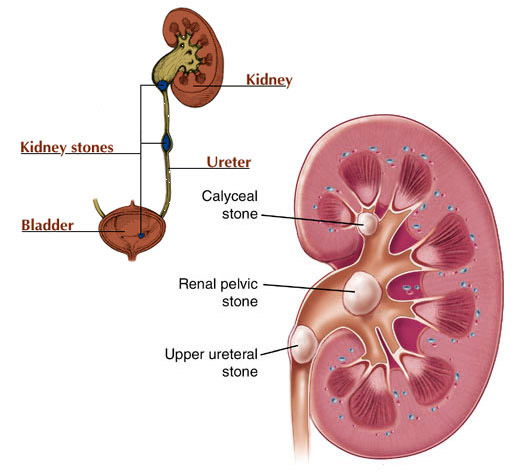Overview
Hardened mineral deposits formed in the kidney are called kidney stones (calculi). These originate as microscopic particles and over the course of time develop into stones. Medically this condition is known as nephrolithiasis or renal stone disease. The kidneys filter waste products from the blood and add them to the urine. When waste materials in the urine do not dissolve completely, crystals and later kidney stones are likely to form. Some stones may pass out of the kidney or get lodged in the ureter (tube that carries urine from the kidney to the bladder) and cause severe pain that starts from back and radiates to the side or groin. A lodged stone can block the flow of urine and build a back pressure in the affected ureter and kidney and results spasm causing severe pain.
Sign & Symptoms
Some small and smooth kidney stones may remain in the kidney or pass without causing pain. Stones that lodge in the ureter (tube that carries urine from the kidneys to the bladder) cause spasm in the urinary system and produce pain. This pain is unrelated to the size of the stone.
Other symptoms of kidney stones may include the following:
- Backache & flank pain
- Blood in the urine (Hematuria)
- Increased frequency of urination
- Nausea and vomiting
- Pain and burning during urination (Dysuria)
- Fever, chills, loss of appetite (U.T.I)

Diagnosis
Laboratory Tests
- Urine Routine & Microscopy
- Ultrasound (USG)
- X-Ray KUB
- Kidney Function Test
- Intravenous Pyelogram (IVP)
- Complete Blood Count
Treatment
Extracorporeal Shock Wave Lithotrispy (ESWL) uses highly focused electro magnetic waves projected from outside the body to crush kidney stones anywhere in the urinary system. The stone is reduced to sand-like particles that can pass in the urine. Large stones may require more than one sessions. It can be used for patients of all age groups and those who have heart and breathing problems. However, the procedure is contraindicated for pregnant women. ESWL by 4th generation “DORNIER SIGMA LITHOTRIPTER” with ultrasound attachment helps to treat even radioluscent stones, which are not visible in normal fluoroscopy Lithotripters.
Percutaneous Nephrostolithotomy (PCNL) is performed under epidural or spinal anaesthesia. Percutaneous ( through skin) removal of kidney stones (lithotomy) is accomplished through a small hole 1 cm is back. A telescope along with the mechanical lithotripter in inserted to break the stone into fine particles so as to achieve a stone-free status in large and complicated stones. This procedure usually requires hospitalization, and most patients resume normal activity within 2 weeks. Now mini perc (mini PCNL) uses smaller hole is back (6-7 mm)
Ureterorenoscopic Lithotrispy with Holmium Laser is performed under epidural and spinal anaesthesia to treat stones located in the middle or lower ureter. A small, fiberoptic instrument (ureteroscope) is passed into the ureter. Large stones are fragmented using 100 / 20 Watt Coherent Holmium Laser. The laser fragments the stone into sand like particles, which are then flushed out through the natural urinary passage. The advantage of Holmium Laser is its ability to fragment stones of all compositions with precision. Thus, it is the most effective laser for the treatment of urinary stones. Patients are generally admitted on the same day of the treatment and are discharged next day, which means only 24 hours of hospitalization is required.